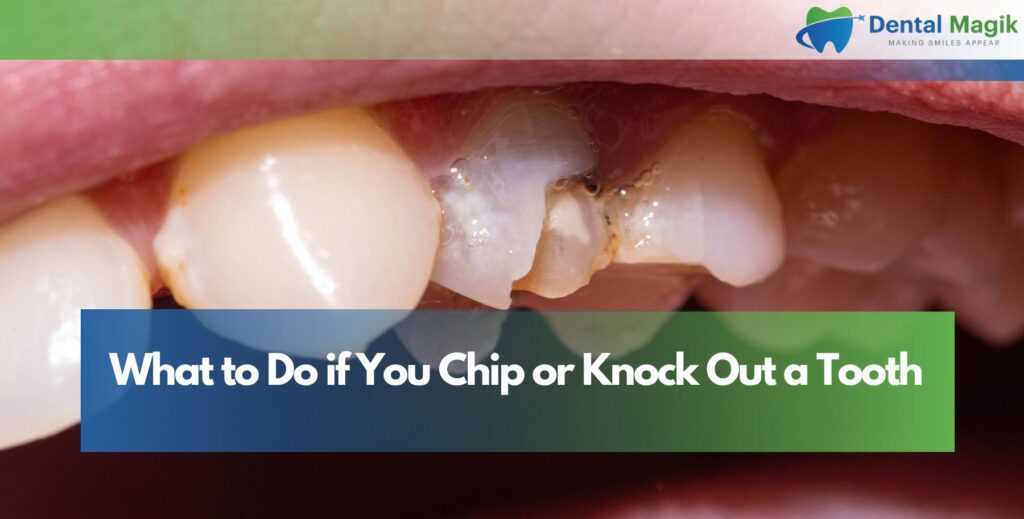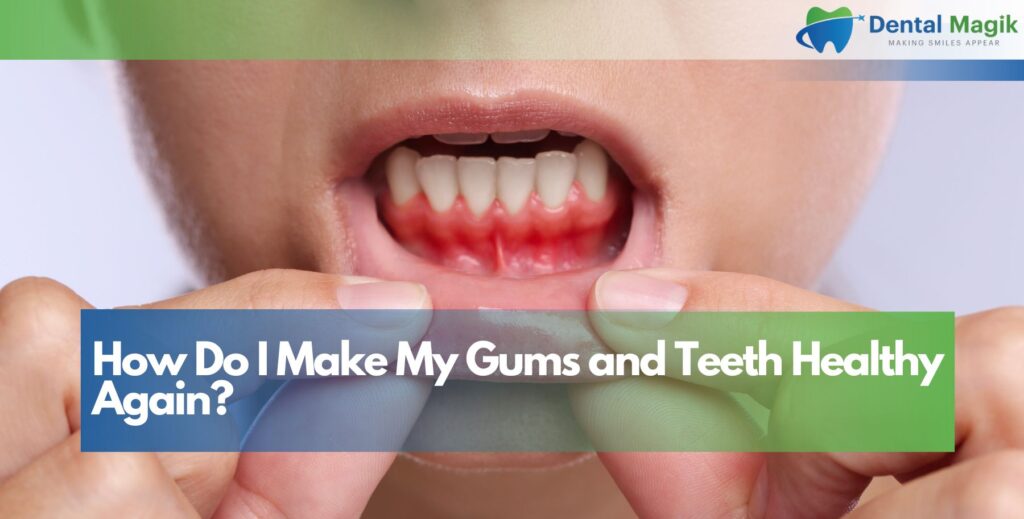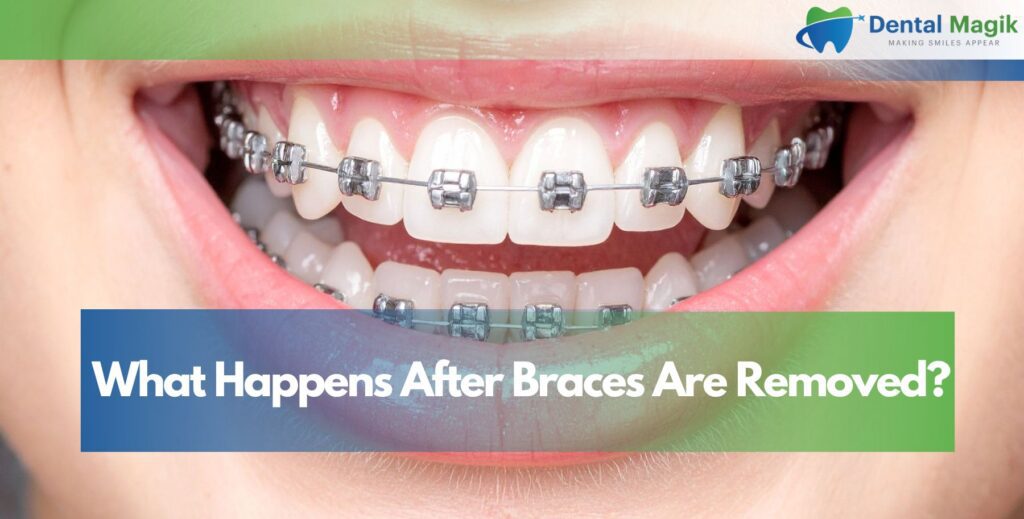Dental trauma can occur unexpectedly during sports activities, accidents, or even routine daily activities like eating hard foods. Knowing how to respond immediately to a chipped or knocked-out tooth can mean the difference between saving or losing a natural tooth permanently. Quick action and proper emergency care significantly improve the chances of successful treatment and tooth preservation, making it essential for everyone to understand the critical steps to take during these dental emergencies.
Table of Contents
Immediate Response to Chipped Teeth
Tooth chips range from minor enamel fractures to severe breaks that expose the tooth’s nerve, and your immediate response can prevent complications and preserve tooth structure for successful repair. The severity of the chip determines the urgency of treatment and the type of intervention required.
Assessing the Damage
Small chips affecting only the outer enamel may not cause immediate pain but still require professional evaluation to prevent future problems. Larger fractures that expose the underlying dentin or pulp chamber typically cause significant pain and sensitivity to temperature changes and pressure.
Sharp edges from chipped teeth can cut your tongue, cheeks, or lips, creating additional injuries that require attention. Bleeding from the tooth itself indicates pulp exposure and represents a dental emergency requiring immediate professional care.
Run your tongue gently over the affected tooth to assess the extent of damage, but avoid pressing hard or chewing on the injured area. Visual inspection using a mirror can help determine if the chip is superficial or involves deeper tooth structures.
Initial Pain and Discomfort Management
Over-the-counter pain medications including ibuprofen or acetaminophen can help manage discomfort while you seek professional treatment. Cold compresses applied to the outside of the mouth for 15-minute intervals can reduce swelling and numb pain in the affected area.
Avoid extremely hot or cold foods and beverages that can trigger severe pain in exposed tooth nerves. Soft foods and careful chewing on the opposite side of your mouth can prevent further damage to the chipped tooth.
Temporary dental cement or dental wax available at pharmacies can cover sharp edges and protect exposed areas until you receive professional treatment. These temporary measures provide short-term relief but should never replace proper dental care.
Protecting the Chipped Area
Rinse your mouth gently with warm salt water to clean the area and reduce bacterial contamination of exposed tooth surfaces. Avoid vigorous rinsing that could dislodge loose tooth fragments or cause additional trauma to injured tissues.
Save any large tooth fragments in milk or saliva if possible, as your dentist may be able to reattach them during treatment. Clean fragments gently with water if they’re dirty, but avoid scrubbing or using soap that could damage cellular structures.
Avoid sticky or hard foods that could cause further chipping or complete tooth fracture. Sugar-free gum should not be chewed near the injured tooth as it could pull away loose fragments or temporary coverings.
Emergency Protocol for Knocked-Out Teeth
A completely avulsed tooth represents one of the most urgent dental emergencies, with time being critical for successful reimplantation. Proper handling and immediate action within the first 30 minutes provide the best chances for tooth survival and long-term success.
Critical Time Factors
The periodontal ligament cells that attach your tooth to the socket can only survive outside the mouth for a limited time. Immediate reimplantation within 30 minutes offers the highest success rates, while delays beyond 2 hours significantly reduce the likelihood of successful treatment.
Dry storage kills periodontal ligament cells rapidly, making proper storage media essential for preserving tooth viability. Every minute counts when dealing with knocked-out teeth, so prompt action and immediate professional care are crucial for optimal outcomes.
Age factors also influence success rates, with younger patients typically experiencing better outcomes due to greater healing capacity and more vital periodontal tissues. However, reimplantation attempts are worthwhile for patients of all ages when proper protocols are followed.
Proper Handling Techniques
Never touch the tooth root when handling a knocked-out tooth, as damage to the periodontal ligament can prevent successful reimplantation. Hold the tooth by the crown (the white portion you normally see) and avoid grasping the root surface under any circumstances.
Gently rinse the tooth with clean water if it’s dirty, but never scrub or use soap, alcohol, or other cleaning agents that can damage delicate tissues. Brief rinsing for 10 seconds is sufficient to remove visible debris without compromising cell viability.
Attempt gentle reimplantation if you’re comfortable doing so and the tooth appears intact. Position the tooth in the socket at the same level as adjacent teeth and bite gently on a clean cloth or gauze to hold it in place. Don’t force the tooth into the socket if it doesn’t fit easily, as this could cause additional damage.
Storage and Transportation Methods
If immediate reimplantation isn’t possible, proper storage becomes critical for preserving tooth viability. Fresh milk serves as an excellent storage medium because its osmolarity and pH are compatible with human cells and can maintain cell viability for several hours.
Hank’s Balanced Salt Solution represents the ideal storage medium for avulsed teeth and is available in some emergency kits and school nurse offices. This specialized solution can preserve periodontal cells for extended periods and significantly improve treatment outcomes.
Saliva storage by placing the tooth in the patient’s mouth (for mature patients who won’t swallow it) or in a container with fresh saliva provides adequate preservation when milk isn’t available. Avoid water storage as it can cause cell swelling and death due to osmotic imbalance.
Transport the tooth and patient to a dental office or emergency room immediately, keeping the storage container at room temperature rather than cooling or heating it. Cold storage can damage cells, while excessive heat accelerates cellular deterioration.
Professional Treatment Options
Modern dentistry offers various treatment approaches for chipped and knocked-out teeth, with success rates depending on injury severity, time factors, and patient cooperation with post-treatment care.
Restoration Techniques for Chipped Teeth
Small chips can often be smoothed and polished during a single appointment, removing sharp edges and preventing further damage. Dental bonding using tooth-colored composite resin provides excellent results for minor to moderate chips and can be completed immediately.
Porcelain veneers offer superior aesthetics and durability for front teeth with significant chips or multiple cosmetic concerns. These thin shells are custom-fabricated to match your natural teeth and bonded to the tooth surface for long-lasting results.
Dental crowns become necessary when extensive tooth structure is lost or when the chip exposes the tooth’s nerve. Crown placement typically requires two appointments but provides complete protection and restoration of tooth function and appearance.
Reimplantation Procedures
Professional reimplantation involves careful cleaning of both the tooth and socket, assessment of root fractures or damage, and gentle repositioning of the tooth in its original location. Local anesthesia ensures patient comfort during the procedure.
Splinting the reimplanted tooth to adjacent teeth using flexible materials allows healing while preventing excessive movement that could disrupt the reattachment process. Splints typically remain in place for 2-4 weeks depending on injury severity.
Root canal therapy is often necessary for reimplanted teeth because the pulp tissue rarely survives the trauma of avulsion. Endodontic treatment can be performed immediately or delayed depending on root development and clinical circumstances.
Long-term Monitoring and Care
Regular follow-up appointments are essential for monitoring healing and detecting complications such as root resorption, ankylosis, or infection. Radiographic examination at specific intervals helps assess the success of treatment and identify problems early.
Antibiotic therapy may be prescribed to prevent infection in contaminated cases or when significant tissue damage is present. Tetanus prophylaxis should be considered for patients with incomplete vaccination status who sustain oral trauma.
Activity restrictions including avoiding hard foods and contact sports help protect healing tissues and prevent reinjury during the critical healing period. Soft diet recommendations and oral hygiene modifications support optimal healing while maintaining oral health.
Prevention Strategies and Risk Reduction
Proactive measures can significantly reduce the risk of dental trauma and help preserve your natural teeth throughout your lifetime. Prevention remains the most effective approach to avoiding the complications and costs associated with traumatic dental injuries.
Sports-Related Injury Prevention
Custom-fitted mouthguards provide superior protection compared to over-the-counter alternatives and should be worn during all contact sports and high-risk activities. Professional fabrication ensures proper fit, comfort, and maximum protection for your specific mouth shape.
Proper protective equipment including helmets, face shields, and mouth guards should be mandatory for young athletes participating in sports with high injury rates. Equipment maintenance and regular replacement ensure continued effectiveness of protective gear.
Sports education about injury risks and prevention techniques can help athletes and coaches make informed decisions about safety measures and risk management. Team policies requiring protective equipment create safer environments for all participants.
Lifestyle Modifications for Dental Safety
Avoid chewing on hard objects including ice, popcorn kernels, hard candy, and non-food items that can cause unexpected tooth fractures. Awareness of potentially damaging habits helps prevent unnecessary dental trauma.
Proper nutrition including adequate calcium, vitamin D, and other essential nutrients helps maintain strong teeth and supporting structures that are more resistant to injury. Regular dental care identifies and addresses weakened teeth before trauma occurs.
Home safety measures including securing loose rugs, improving lighting, and removing tripping hazards can prevent falls that often result in dental injuries. Childproofing measures protect young children from common household hazards that cause oral trauma.
Emergency Preparedness
Emergency dental kits containing gauze, temporary filling material, pain medication, and emergency contact information can provide immediate relief and guidance during dental emergencies. Kit contents should be regularly updated and family members should know their location.
Emergency action plans including contact information for dental offices, after-hours services, and hospital emergency departments ensure rapid access to professional care when needed. Practice scenarios help family members respond appropriately during stressful emergency situations.
Education about proper emergency response should include all family members and caregivers who might need to respond to dental trauma. Regular review of emergency procedures and contact information keeps everyone prepared for unexpected situations.
Conclusion
Knowing what to do when you chip or knock out a tooth can save you from permanent damage and expensive restorative treatments. Immediate action, such as protecting fragments, managing pain, and seeking professional help quickly, significantly increases the chances of saving your natural tooth. Always remember—timely care and emergency preparedness are the keys to preserving your smile.
FAQs
What should I do immediately after chipping a tooth?
Rinse your mouth with warm salt water, cover sharp edges with dental wax, and avoid chewing on the affected side. Save any broken fragments and see a dentist promptly for evaluation.
Is a chipped tooth a dental emergency?
Small chips may not be emergencies but should still be checked by a dentist. Larger chips exposing dentin or pulp, or those causing pain, are dental emergencies that require immediate treatment.
How do I manage pain from a chipped tooth?
Use over-the-counter pain relievers like ibuprofen, apply a cold compress to reduce swelling, and avoid hot or cold foods that may trigger sensitivity. Temporary dental wax can protect exposed areas.
What should I do if my tooth gets knocked out?
Handle the tooth by the crown, never the root. Rinse it gently with water, reinsert it into the socket if possible, or store it in milk or saliva. Seek dental care within 30 minutes for the best chance of saving it.
Can a knocked-out tooth be saved?
Yes, if reimplanted within 30–60 minutes, a tooth has the highest chance of survival. Professional treatment, proper handling, and correct storage increase the success rate significantly.
What storage medium is best for a knocked-out tooth?
Fresh milk, Hank’s Balanced Salt Solution (if available), or the patient’s saliva are ideal. Never store a tooth in plain water, as it can damage periodontal cells.
What professional treatments are available for chipped teeth?
Depending on severity, options include dental bonding, porcelain veneers, or dental crowns. For severe fractures with pulp exposure, root canal therapy followed by a crown may be necessary.
How do dentists treat a knocked-out tooth?
Dentists clean the socket, reposition the tooth, and stabilize it with a splint. Root canal therapy may follow, depending on pulp survival. Long-term monitoring ensures proper healing.
How can I prevent chipping or knocking out teeth?
Wear a custom-fitted mouthguard during sports, avoid chewing hard objects like ice or hard candy, maintain strong teeth with proper nutrition, and eliminate household hazards that may cause falls.
What should I avoid doing if I knock out a tooth?
Do not touch the root, scrub the tooth, or store it in water. Avoid delaying treatment—every minute counts in saving the tooth.







